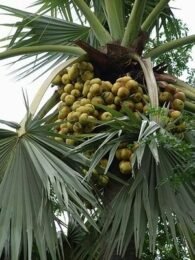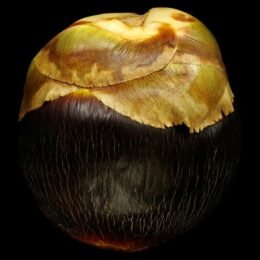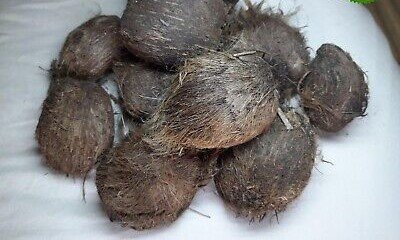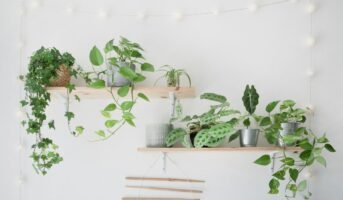What is a Borassus palm?

Source: Pinterest
Borassus flabellifer is also known as lontar palm, palmyra palm or the toddy palm. The Borassus flabellifer tree is native to Malaysia, India and Sri Lanka. The Borassus flabellifer has whitish flowers in clusters.
What does Borassus flabellifer look like?
It is a large fan palm that has brownish grey trunk and has strong palm leaves that has spines on them. While male flowers bloom in some trees, some trees bloom female flowers. The male flowers are small in size and the female flowers are large and subsequently become brown fleshy fruits.

Source: Pinterest
Palm seeds

Source: Pinterest
The doub palm, sometimes called the palmyra palm, the tala or tal palm, the toddy palm, the wine palm, or the ice apple, is a species of Borassus that is indigenous to South Asia and Southeast Asia. It is said to have been naturalised in Socotra and some areas of China. Native to tropical Africa, the palmyra palm has been farmed and naturalised all throughout India.

Source: Pinterest
Borassus Flabellifer: Quick facts
| Botanical name: Borassus Flabellifer |
| Type: A big tree |
| Leaf type: The leaves are Green |
| Flower: No |
| Also known as: Palmyra palm, the tala or tal palm, the toddy palm, the wine palm, or the ice apple |
| Height: 20-35m tall |
| Season: Summer |
| Sun exposure: Keep in shade with a few hours of direct sunlight |
| Ideal temperature: 70 to 90 degrees Fahrenheit |
| Soil type: Well-drained |
| Soil pH: Slightly acidic to slightly alkaline |
| Basic requirements: Intermittent watering, indirect sunlight, home-made fertiliser |
| Ideal location for placement: Outdoors |
| Ideal season to grow: Summer |
| Maintenance: Low |
Borassus Flabellifer: Benefits
It is a large-scale rainwater saviour or natural rainwater harvester; its roots aid in reducing soil erosion; it also helps to increase groundwater; its fronds can be used to make a roof covering that is resistant to rain, and its trunk is employed in the manufacture of bricks because it provides moderately long-lasting heat.
What is the antimicrobial activity of Borassus flabellifer?
- All components of the toddy palm are known to have several traditional medicinal uses. The young plant is purported to treat gonorrhoea, diarrhoea, and biliousness. Young roots have diuretic and anthelmintic effects.
- A decoction is provided in some respiratory illnesses. Additionally, dried roots can be smoked to treat nasal issues.
- To treat enlarged spleen and liver as well as heartburn, one can consume the flower’s ash. As a mouthwash, the bark decoction is combined with salt.
- The bark is used to make charcoal that is used as a dentifrice. The flower stalk’s sap is valued for its tonic, diuretic, stimulant, laxative, anti-phlegmatic, and amoebic properties.
- All types of ulcers are dressed with fresh toddy that has been heated to encourage fermentation.
- The dried male flower spikes, leaf petioles, and the apical bud all have diuretic properties. The ripe fruit’s pulp soothes dermatitis.
Borassus Flabellifer: Side effects
- For pregnant and nursing women, there is inadequate evidence to recommend the usage of Borassus fruits. Therefore, it is essential to get medical advice before using the fruit as a herb.
- Older people and children should receive it with special caution because of their weakened immune systems and potential for adverse health effects.

Source: Pinterest
FAQs
What type of plant is Borassus Flabellifer?
Borassus Flabellifer is a landscape palm species that is grown as an appealing ornamental tree for planting in gardens and parks because of its clean habits, enormous size, and attractive growth pattern.
Where did the plant originate?
Borassus flabellifer is found in Bangladesh, Cambodia, China South-Central, India, Jawa, Laos, Lesser Sunda Is., Malaya, Myanmar, Socotra, Sri Lanka, Sulawesi, Thailand, and Vietnam. South and Southeast Asia.
Housing News Desk is the news desk of leading online real estate portal, Housing.com. Housing News Desk focuses on a variety of topics such as real estate laws, taxes, current news, property trends, home loans, rentals, décor, green homes, home improvement, etc. The main objective of the news desk, is to cover the real estate sector from the perspective of providing information that is useful to the end-user.
Facebook: https://www.facebook.com/housing.com/
Twitter: https://twitter.com/Housing
Email: [email protected]











